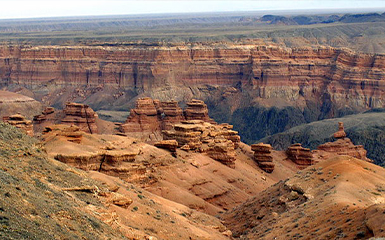Aisha-Bibi mausoleum
Aksu-Zhabagly
Aktau
Almaty
Altyn-Emel
Arystan Bab
Atyrau
Azret Sultan
Babaji Khatun
Bayanaul
Begazy necropolis
Beket-Ata Mosque
Almaty Lake
Lake Burabay
shakpak-ata-cave
Charyn Canyon
Hilvet mosque
Hodja Ahmad Yesevi
Holy Cave
Kaindy
Kapchagay
Karakhan mausoleum
Karkaraly
Kizhel Kensh
Kolsai Lakes
Korgalzhyn
Balkash lake
Lake Shaitankol
Jochi Khan
Karasai and Agyntai Batyr
Kozy Korpesh and Bayan Sulu
Mashkhur Zhussip Kopeyuly
Rabiga Sultan Begim
Kenty-Baba
Nomad Fortress
Nur-Sultan
Ruins of Otrar
Ruins of Sauran
Shopan-Ata
Shymbulak
Sultan-Epe
Tamgaly Gorge
Tamgaly-Tas
Alasha Khan
Torysh
Zhirensakal Peak
Charyn Canyon is a canyon on the Sharyn River in Kazakhstan (near the border with China). The canyon is roughly 90 kilometres (56 mi) long. It is part of Charyn National Park. Over time, the canyon has acquired colourful formations of various shapes and sizes. Although much smaller than the Grand Canyon, it has been described as equally impressive.
Charyn canyon is a complex of chapels, towers, animals, etc., formed under the influence of the weathering of sedimentary rocks. It is a unique natural object with peculiar relief forms in its shape.
Some scholars think that the name of the river comes from the Uighur word "Sharyn" meaning "tooth tree". There is another interpretation that it is a derivative of the root word "çar" meaning "cliff" in Turkish. Both of these interpretations are appropriate for site conditions where the terrain is steep and ash trees are present.
The geological formation of the canyon consists of sedimentary red sandstone, which has been subjected to the "atmogenic process" of water and wind erosion, resulting in "rare and colourful formations" in the form of sculptures. Part of the canyon is known as the Valley of Castles (Dolina Zamkov) due to its unusual rock formations and is 3 kilometres (1.9 miles) long and 100 meters (330 ft.) deep.
The multicolour rock layers are the product of different stages of sedimentary deposits with volcanic lava rocks at the bottom and red debris at the top. Charyn Canyon consists of five different canyons, namely Kaleler Valley (the most popular part of Charyn Canyon), Temirlik Canyon, Yellow Canyon, Red Canyon and Bestamak Canyon. There are also a number of smaller canyons or trails, including the Kurtogay Canyon and the Tazbas trail.
Adventure sports activities on the river include white-water rafting and canoeing. Fishing of local fish species called "Naked Osman" is also common. Further down the canyon is a dry region of the valley called the Red Canyon or "Valley of Castles". It stretches for about 1 km and has a depth of about 100 meters (330 ft). In the valley of the gorge, there is a course with naturally hewn red stone formations.
The Relic Forest is located about 20 kilometres (12 miles) from the canyon. The forest, under the canyon's shadow, is known as the "Sogdian ash" (Ash Tree) (a tree said to have descended from the Ice Age). The site is considered unique across various accounts. It was declared a protected area in 1964. Now integrated with Charyn National Park. Other than ash, other tree categories in the area include willow, poplar, and barberry.
Researchers, providing a wealth of data for climate studies, have discovered an “unbroken” geological record of five million years.
Charyn State Park, a state and nature conservation and science institution, protects the nature monument.


